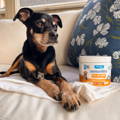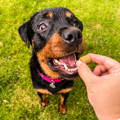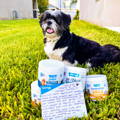is a health condition causing your Dog's Shedding?
Jump to Section

When we look at our dog, the first thing we notice–aside from big, adorable eyes–is their skin and coat. The condition of our pet’s outward appearance won’t just depend on how well they’re groomed, but how well their entire body is functioning. The skin is the body's largest organ, so it makes sense that the health of our internal organs would be connected to our dog’s skin health.
When aiming for optimal skin and coat health, multiple factors should be considered. The appearance of your dog’s skin and coat is linked to their environment, genetics, internal organ system function, lifestyle, nutrition, and more!
So which health conditions will affect your dog’s skin and coat, and what can you do about shedding? We’re covering the basics of dog physiology while highlighting treatments like supplements for dog shedding, itching, flaking, and more.
What is shedding in dogs, and when does it happen?
- Akita
- Alaskan Malamute
- Beagle
- Cardigan Welsh Corgi
- Chow Chow
- German Shepherd
- Golden Retriever
- Great Pyrenees
- Labradoodle
- Labrador Retriever
- Newfoundland
- Old English Sheepdog
- Pembroke Welsh Corgi
- Pug
- Rottweiler
- Rough Collie
- Shetland Sheepdog
- Siberian Husky
- Toy Poodle
Dog shedding is also a seasonal occurrence for most dog breeds. In spring, dogs need to shed excess fur to stay cool in hot weather. In fall, they’ll refresh their coat and build a thicker, warmer undercoat for cold weather resistance. Regular brushing is a must for any coat type–coarse, silky, wiry–and will help your dog shed their coats more efficiently. Finding a special brush for long fur or a brush for short fur will help keep the grooming experience more comfortable for your furry friend.
Seasonal changes and breed aren’t the only factors that trigger dog shedding or other skin and coat issues. Your dog’s internal health will play an even bigger role in determining how well their skin and coat thrive!

When should you worry about your dog’s shedding?
While most shedding is normal and shouldn’t be cause for concern, it’s important to know when shedding isn’t normal.
What is considered too much shedding? The rate of fur shedding will be different for every pet, with factors such as breed, coat density, and fur length playing a part. Knowing your dog’s usual rate of shedding––noted when they’re puppies or when you first adopt them––will be important for determining their baseline shedding cycles.
Taking these factors into account, keep in mind that excess shedding will have a few hallmark symptoms. For one, if your dog’s hair is falling out in clumps or causing severe thinning or balding, you should check with your veterinarian. Excess shedding accompanied by skin inflammation, itching, or abnormally brittle fur are not normal symptoms of shedding and should also be reported to your vet.
Health conditions that affect your dog's skin and coat
Heart disease
The heart is an important muscle when it comes to pumping blood around the body, so heart diseases like congestive heart failure (CHF), hypertrophic cardiomyopathy (HCM), dilated cardiomyopathy (DCM), and heartworms reduce blood flow to the skin and other organs.
Blood pressure abnormalities
Hypotension (reduced blood pressure) causes reduced blood flow to the skin and other organs. Although hypertension (elevated blood pressure) increases blood flow around the body, it stresses detoxifying organs like the kidneys and liver and negatively affects their function.
Elevated blood lipids
The body needs fat to function, but high lipids (fats) like cholesterol thicken the blood and reduce its ability to reach the skin and penetrate other important organs.
Obesity
If an animal is obese, that means they have grown too large for their heart and vessels to transport blood to the skin effectively. Pets struggling with obesity will also suffer from skin problems as a result of elevated blood lipid levels, infection and inflammation of skin folds, and increased abrasion (rubbing) by collars, harnesses, and environmental surfaces.

Beyond the negative effects of reduced blood flow to the skin, health conditions affecting key organ systems will also play a part in your dog’s skin and coat health. Those conditions include:
Adrenal glands
The adrenal glands produce anti-inflammatory steroids and water-balancing hormones. Cushing's disease (hyperadrenocorticism) involves an excessive production of steroids from the adrenal glands and causes thin skin, sparse hair coat, and chronic bacterial, yeast, or other infections.
Addison’s disease (hypoadrenocorticism) involves reduced production of steroid and water-balancing hormones, causes less blood flow to the skin, and unnecessarily stresses all organ systems.
Thyroid glands
The thyroid glands are responsible for producing hormones that maintain blood flow, blood lipid levels, and metabolism. Hypothyroidism is the under-production of thyroid hormones which leads to reduced blood flow, elevated blood lipid levels, and weight gain.
Hyperthyroidism is the overproduction of thyroid hormones, which increases blood flow around the body but negatively impacts whole-body health by elevating blood pressure and stressing all organ systems.
Kidneys
The kidneys function as one of the body’s filtration systems to cleanse the blood of toxins, maintain electrolyte and water balance, and prevent glucose and protein loss in urine. Kidney disease causes nitrogen (from the breakdown of protein) and other toxins to build up in the blood and, by extension, negatively impacts the skin and coat.
Liver
The liver also functions as the blood’s filter and is responsible for regulating immune function and blood protein and fat levels. Diseases of the liver weaken immune-system function, cause increased levels of blood lipids and toxins, and reduce blood protein levels.
Digestive tract and pancreas
The digestive tract has a major connection to internal organs and skin health. During the first phase of digestion, a dog's stomach uses a strong acid to store and break down food. The small intestine moves that food from the stomach to the large intestine, using digestive enzymes from the pancreas to absorb nutrients. Finally, the large intestine (colon) forms and stores feces and maintains hydration.
Problems in any or all of these areas lead to reduced nutrient absorption, hydration imbalances, and immune system malfunction. Talk to your veterinarian about regularly performing diagnostic testing with blood, urine, and fecal samples to assess your pet’s internal organ health and monitor for infection with bacteria, parasites, and viruses.
If keeping your dog’s skin and coat soft and glossy is important to you, that’s just another reason to help keep your pet’s internal health in top shape!

How nutrition can benefit skin and coat health
This won’t come as a surprise: Nutrition is an essential part of your dog’s whole-body health. From the foods and treats our pets eat to the amount of water they consume, there’s a direct correlation between nutrition and skin and coat health!
Vetnique’s Vet Advisory Board member and house-call veterinarian Dr. Patrick Mahaney is an expert in healthy eating habits for pets and their families. Check out his top vet-recommended tips for healthy skin and a glossy coat!
Feed a nutritionally complete and balanced diet
“Nutritional deficiencies can contribute to skin and coat abnormalities,” Dr. Mahaney advises “So your pet’s primary meals must be nutritionally-complete and balanced.”
Eating foods that aren’t nutritionally-complete and balanced (i.e., supplemental foods) on a short-term basis shouldn’t lead to nutritional deficiencies or subsequent skin and coat problems. However, beware that long-term feeding of nutritionally-lacking meals can negatively impact the skin, coat, and other body systems.
Prioritize whole foods over processed foods
Dr. Mahaney advises that whole-food diets can benefit a pet’s skin and coat more so than long-term feeding of meals exclusively composed of kibble and other processed foods.
“Whole-food nutrients contain enzymes and co-factors essential to digestion and are often better absorbed by the digestive tract than processed foods. Additionally, the inherent moisture of whole foods also promotes better hydration and blood flow than foods and treats that have had their moisture removed.”
Feed a human-grade foods instead of feed-grade
“Most pet foods and treats are made with feed-grade ingredients that have been deemed unfit for human consumption,” Dr. Mahaney reveals. “Feed-grade ingredients are permitted to have a higher level of toxins–such as mold-based aflatoxin and vomitoxin–which only needs to be ingested in small quantities to damage the gastrointestinal tract (stomach, small and large intestine), kidneys, liver, pancreas, and immune system. Such toxins are even carcinogenic (cancer-causing).”
Damage to the GI tract and liver from these ingredients might have a negative effect on skin and coat health, leading to dog shedding, skin flaking, and more.
Avoid unnecessary food and treat ingredients
Many processed pet food and dog treats contain artificial colors, artificial flavors, and chemical preservatives. Some of the artificial colors in pet foods and dog treats––Blue 2, Red 40, Yellow 5 and 6––can contribute to hypersensitivity (allergic-type) reactions, behavior problems, and cancer in humans.
You’ve probably heard of caramel color before; it’s a common ingredient in processes people food. Pet companies also use caramel color to make foods and treats appear more like real meat. Beware, pet parents: this artificial color contains 4-methylimidazole (4-MIE), a known animal carcinogen.
For these reasons, Dr. Mahaney suggest that pet parents should “take steps to eliminate artificial colors from pet meals and treats. Generally, artificial flavors aren’t inherently harmful but can cause digestive tract responses like food aversion, vomiting, or stool problems and shouldn’t enter our pets’ bodies.”
Reduce calories to promote better health
Pets that eat an appropriate amount of calories each day to maintain an ideal body weight have better long-term overall health. Dr. Mahaney's suggests partnering with your veterinarian to “assess your pet’s weight and body condition score (BCS) and determine if weight loss is needed.”
Try adding a daily supplement
If you're looking to boost your dog's diet, "consider the addition of daily dietary supplements to promote skin and coat health," says Dr. Mahaney. The best dog supplements for skin and coat will include skin-beneficial ingredients like:
Omega Fatty Acids
Omega fatty acids are important in promoting the health of skin, hair, joints, nerves, and other body tissues. Omegas 3 and 9 have natural anti-inflammatory effects, while Omega 6 provides the basic building blocks of nerve tissue. Seek dog allergy supplements that contain multiple types of vegetarian and animal-based omega-fatty acids like flaxseed, krill, safflower oil, and salmon oil for dogs’ skin health.
Minerals
Zinc Gluconate is a mineral crucial to skin health. Zinc promotes protein synthesis for more supple and resilient skin, and has anti-inflammatory and antioxidant effects for overall skin barrier health.
Vitamins
Vitamins like B7 (Biotin) contain proteins, carbohydrates, and fat metabolism that provide the basic building blocks of skin and hair. B9 (Folic Acid) promotes hydration by enhancing the skin’s barrier function to protect against environmental irritants and infectious organisms.
If you’re looking for a skin and coat supplement for dogs with dry skin, Vitamin E is a moisturizing ingredient that also boasts antioxidant and anti-inflammatory effects to shield the skin from UV damage.
Dog grooming and parasite prevention
As our dog’s first line of defense, the skin and coat are most susceptible to inflammation and trauma from the environment. What do we mean by “trauma”? Think allergens, irritants, rubbing against surfaces, pollutants, insect bites and stings, temperature extremes, UV rays, and more.
We play a key role in our pets’ skin and coat health. By controlling indoor and outdoor environments, we have the power to reduce exposure to many of these stressors. In addition to keeping their environments clean, we can also keep our dog’s skin soft and fur fuzzy with grooming and parasite prevention.

Grooming
Sticking with a regular grooming schedule will keep excessive hair, skin cells, allergens, bacteria, yeast, and other infectious organisms at bay. Another benefit of grooming? It promotes blood circulation––which is good for health fur growth––and normal skin surface temperature.
Here’s a surprising statistic: Non-shedding dogs have greater grooming needs than shedding dogs. That’s because dog breeds who don’t shed need help getting rid of that extra fur and skin cell turnover. Generally, veterinarians recommend bathing your pooch every seven to 14 days, depending on how dirty your dog’s fur or skin becomes. Shedding dogs often have less-frequent grooming needs, but their skin and coat still benefit from regular brushing and bathing.
For routine bath time, stick to an oatmeal dog shampoo that's designed to be gentle on your dog's skin and coat. Quality formulas can be used more frequently, meaning they won't dry out or strip your dog's skin of its essential moisture.
When skin allergies or infections are present, choose a dog shampoo for allergies with skin-friendly ingredients. Is itching driving your dog crazy? Try a dog shampoo with Pramoxine Hydrochloride to dull the sensation of itching. Is your dog’s skin dry and tight? Hydrolyzed Oats have humectant (water-retaining) properties to help soothe the skin, while Safflower Seed Oil can promote a softer skin surface.
Some dogs struggle with skin conditions that cause excess oil (like seborrheic dermatitis) or skin infections with bacteria, yeast, or mange mites. For these conditions, give bathtime a boost with a Benzoyle Peroxide dog shampoo. This type of medicated shampoo can help by flushing hair follicles, killing infectious organisms, and removing excess oil and skin cells.
Itchy pets can also receive spot-on treatment with an allergy relief spray. Look for ingredients to tag-team itching and irritation like Pramoxine Hydrochloride, anti-inflammatory Hydrocortisone, and skin-soothing Hydrolyzed Oats. You can also use a wipe to gently cleanse and treat bacterial or yeast infections on the skin’s surface––look for dog cleaning wipes with ingredients like Chlorhexidine and Miconazole.
Grooming isn’t just dunking and scrubbing your dog clean! Grooming also includes brushing or combing, which your can do daily to keep your dog’s skin and coat feeling healthy and looking vibrant. Wondering how to stop dogs from shedding? Hypoallergenic silicone dog brushes remove excess hair and skin cells and can be especially useful at bath time for evenly dispersing shampoo through your pet’s fur.
Ready to talk about those less-than-glamorous grooming responsibilities? Your pet’s private parts need trimming, too––especially if those areas are prone to redness and irritation. You’ll want to schedule regular sanitary trims around the penis, vulva, anus, undersides of the paws, and other delicate areas. Even if you have to hire a professional groomer to do it, these trims will prevent fur from accumulating urine, feces, and environmental materials that can contribute to skin inflammation and infection.
Pet nails should also be kept short and clean, as long nails are prone to accumulation of soil and other debris on nail beds which can prompt feet chewing and licking that may require treatment by your veterinarian. Chewing the paws can also lead to bald patches, which is another issue related to skin and coat health.
Parasite Prevention
When it comes to preventing parasites––and the bald spots and skin irritation they cause––partner with your veterinarian to tailor an appropriate parasite prevention plan for your dog’s lifestyle.
Regular use of oral or topical medications can deter fleas, ticks, mosquitoes, and other insects from biting. It can prevent our canine and feline friends from experiencing uncomfortable pain linked to skin irritation, and reduce their risk of contracting heartworm disease and internal parasite infections.
Hopefully we helped ‘shed’ some light on your pet’s skin and coat health! Taking a whole-body approach to the health of your pet’s skin and coat can increase the likelihood that underlying health issues are discovered early, before there’s a significant effect on the skin’s appearance. With your dog’s shedding and itching under control, hopefully you can end their couch ban and give the vacuum a rest!
Join the Pack!

Sign up for exclusive deals, curated pet tips from veterinarians, and product launches!
Pet Parents are Also Reading...
Oct, 2022
Related Articles
























